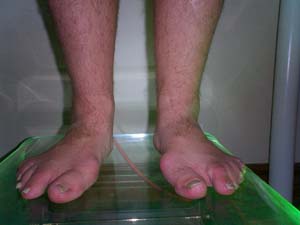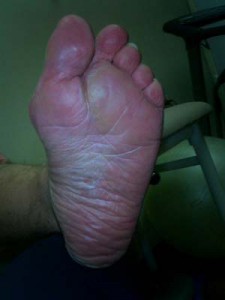

Down Syndrome is a genetic disorder where the cell division of a developing baby results in them having an extra copy of chromosome 21. The result is physical and developmental changes in the child.
Many of these characteristics are well understood and are able to be managed. The related foot conditions are also generally well understood, although management and treatment of these often painful and debilitating symptoms are often overlooked or ignored. Here at My FootDr, we believe that all children with Down Syndrome should be clinically assessed so that the right steps can be taken to help the child feel comfortable, walk and play confidently, and help prevent or slow the onset of other problems.
How are the feet affected in Down Syndrome?
Although children with Down Syndrome share some of the same characteristics, each child is different. Medical researchers have identified more than 50 characteristics which may be found in people with Down Syndrome. Most people will have only a few of these.
The most common defining foot and gait features of Down Syndrome patients include:
- Smaller and/or shorter limbs, fingers, hands, toes and feet
- Low muscle tone and loose ligaments
- Broad feet with a deep plantar crease
- Flat ‘pronated’ feet
- Decreased ankle range of motion
- Abducted and wider base of gait / support
- Excessive external hip rotation (feet pointed outwards)
- Inadequate heel contact during gait (tendency to walk on toes)
- Poor foot clearance during swing phase (tendency to scuff the foot and trip)
- Poor balance
The combination of loose ligaments and low muscle tone often contribute to orthopaedic problems. These characteristics tend to become evident when children learn to walk, as specific physiological differences may be emphasised by gravity. This is where Podiatrists can play a role in aiding Down Syndrome lower-limb development and coordination.
The most common foot and leg conditions we see in Down Syndrome include:
- Sore, tired legs related to flat feet
- Hallux Abducto-Valgus (bunions)
- Plantar Fasciitis (pain in the arch)
- Anterior knee pain related to flat ‘pronated’ feet
- Clawing of the toes
- Calluses and corns and associated ingrown toenails
- Shoe irritation (generally from footwear with insufficient width)
By assessing kids from an early age and as they grow, we can help manage any problems before they become serious or limiting.

Treatment
Selecting the right treatment depends entirely on the symptoms, which can vary as your child grows. Treatment is generally painless and may involve:
1. Custom Foot Orthotics
If flat feet are implicated in the development of symptoms this can be addressed with prescription foot orthotics to assist in maintaining good foot and ankle alignment. Orthotics can be made using softer EVA rubber or 3D printed material depending on the requirement for support or cushion.
2. Supra Malleolar Orthoses (SMO)
The Surestep SMO has revolutionized orthotic management for children with hypotonia. Through the use of extremely thin, flexible thermoplastic, the Surestep SMO compresses the soft tissues of the foot with its patented design; stabilizing children while still allowing for natural development.
Indications that this product will help your child
- Pronation
- Hypotonia
- Triplanar instability in weight-bearing
- Inability to stand independently
- Mild toe-walking
- Developmental delay
- Delay in acquiring gross motor skills
- Poor coordination or balance
Click here to read more about the details on the Surestep SMO and other devices.
3. General Footcare
Hard skin, thickened toenails and corns can be treated painlessly with skilful removal by a podiatrist. This may need to be performed periodically to maintain comfort, although good alignment of the feet with orthotics generally assists in this area too.
4. Wide and Supportive Footwear
It can often be a challenge to find footwear that both fits well and provides adequate support, whilst still being socially acceptable. We have access to almost every supplier of comfort and medical grade footwear, and if we can’t find a shoe to fit, then we can modify or even custom make a pair specifically for you or your child.. Our website has a full listing, and special orders are available.
5. Surgery
Orthopaedic surgery is an option for severe bunion deformities, rigid ankle equinus and other symptoms relating to flexible flat feet. Before surgery is considered, a number of non-invasive treatment options should be considered. Surgery is often the last option following exhaustion of all other conservative measures. Specific advice on the appropriateness of surgery can be discussed with your podiatrist.


